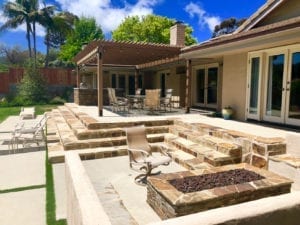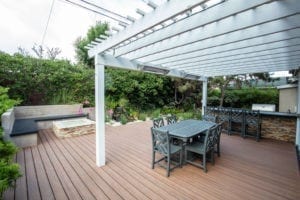Pergolas are an excellent addition to any Los Angeles home, providing shade, aesthetic appeal, and a functional outdoor space. However, to make the most of your pergola project, it’s essential to understand the do’s and don’ts involved in its design, construction, and maintenance.
In this comprehensive guide, we’ll explore the dos and don’ts of pergolas in your Los Angeles home to help you create a beautiful and functional outdoor space that you’ll enjoy for years to come.

The Do’s
1. Plan Your Design Carefully
Before starting your pergola project, spend time planning its design. Then, consider factors like location, size, materials, and style. Also, a well-thought-out design will ensure your pergola complements your home’s architecture and suits your lifestyle.
2. Obtain Necessary Permits
Check with your local government or homeowners’ association to see if you need permits for your pergola construction. Besides, compliance with regulations is essential to avoid potential legal issues later.
3. Choose the Right Materials
Select materials that are suitable for the Los Angeles climate. In connection, cedar, redwood, or aluminum are popular choices due to their durability and resistance to the elements.
4. Consider Climbing Plants
Vines or climbing plants can add beauty and shade to your pergola. Then, choose varieties that thrive in Southern California’s climate, such as bougainvillea or jasmine.
5. Install Proper Lighting
Incorporate lighting into your pergola design. Also, string lights, lanterns, or recessed lighting can create a warm and inviting atmosphere for evening gatherings.
6. Use Quality Hardware
Invest in high-quality hardware and fasteners to ensure your pergola remains sturdy and safe over time.
7. Regular Maintenance
Perform routine maintenance to keep your pergola in excellent condition. Hence, this includes cleaning, sealing, and inspecting for any signs of wear or damage.
8. Consider What It’s Made From
Choose your pergola’s construction material wisely. Also, pressure-treated wood, redwood, cedar, tropical hardwood, modified/composite wood, vinyl, fiberglass, and metal (aluminum/steel) each have their pros and cons. Thus, select the material that suits your style, budget, and maintenance preferences.
9. Remember the Additional Uses
Think beyond shade and consider adding features like hammocks, swing seats, side shade cloths, windbreaks, lighting, and sound systems to maximize your pergola’s functionality.
10. Track the Sun
Optimize the placement and angle of your pergola by considering the sun’s position during the times you plan to use it most. Then, this will enhance comfort and shade.

The Don’ts
11. Neglect Local Building Codes
Don’t ignore local building codes and regulations. Besides, failing to obtain the necessary permits or building your pergola without adhering to the rules can lead to costly legal issues.
12. Rush the Planning Stage
Avoid rushing the planning stage. So, take the time to carefully consider all design aspects, as well as any potential challenges or obstacles.
13. Use Subpar Materials
Don’t compromise on material quality. Low-quality materials may not withstand the Los Angeles climate, leading to premature deterioration and costly repairs.
14. Overlook Drainage
Ensure proper drainage beneath your pergola to prevent water accumulation and potential damage to the structure.
15. Forget About Sun Protection
While pergolas provide shade, they may not offer complete sun protection. Consider adding retractable shades, curtains, or a combination of both to shield against intense sunlight.
16. Neglect Maintenance
Failing to maintain your pergola can lead to unsightly wear and structural problems. Regularly inspect for rot, pests, or loose components and address issues promptly.
17. Expect It to Be Waterproof
Pergolas are not designed to be waterproof. If you want rain protection, consider additional covers or canopies as part of your design.
18. Expect It to Offer Complete Shade
Pergolas provide partial shade. To enhance shade, consider design elements or additional features like shade cloths or plants.
19. Think It Is Maintenance-Free
Regardless of the material you choose, some level of maintenance is required to keep your pergola in good condition. Regular cleaning, staining, sealing, and inspections are essential for long-term durability.
20. Assume Everyone Is a Fan
Pergolas may not be suitable for everyone’s preferences or needs. Some individuals may prefer alternative methods of creating shade or have differing opinions on the aesthetic appeal of pergolas.

A well-designed and properly maintained pergola can enhance the beauty and functionality of your Los Angeles home’s outdoor space. By following the do’s and avoiding the don’ts outlined in this guide, you’ll be well on your way to creating an inviting and enduring addition to your property. Remember that thoughtful planning, quality materials, and adherence to local regulations are key to a successful pergola project in the City of Angels.
Explore 9 Decomposed Granite Landscaping Ideas for more inspirational outdoor ideas.


